Email Marketing
B2B Email Marketing Best Practices and the Biggest Myths
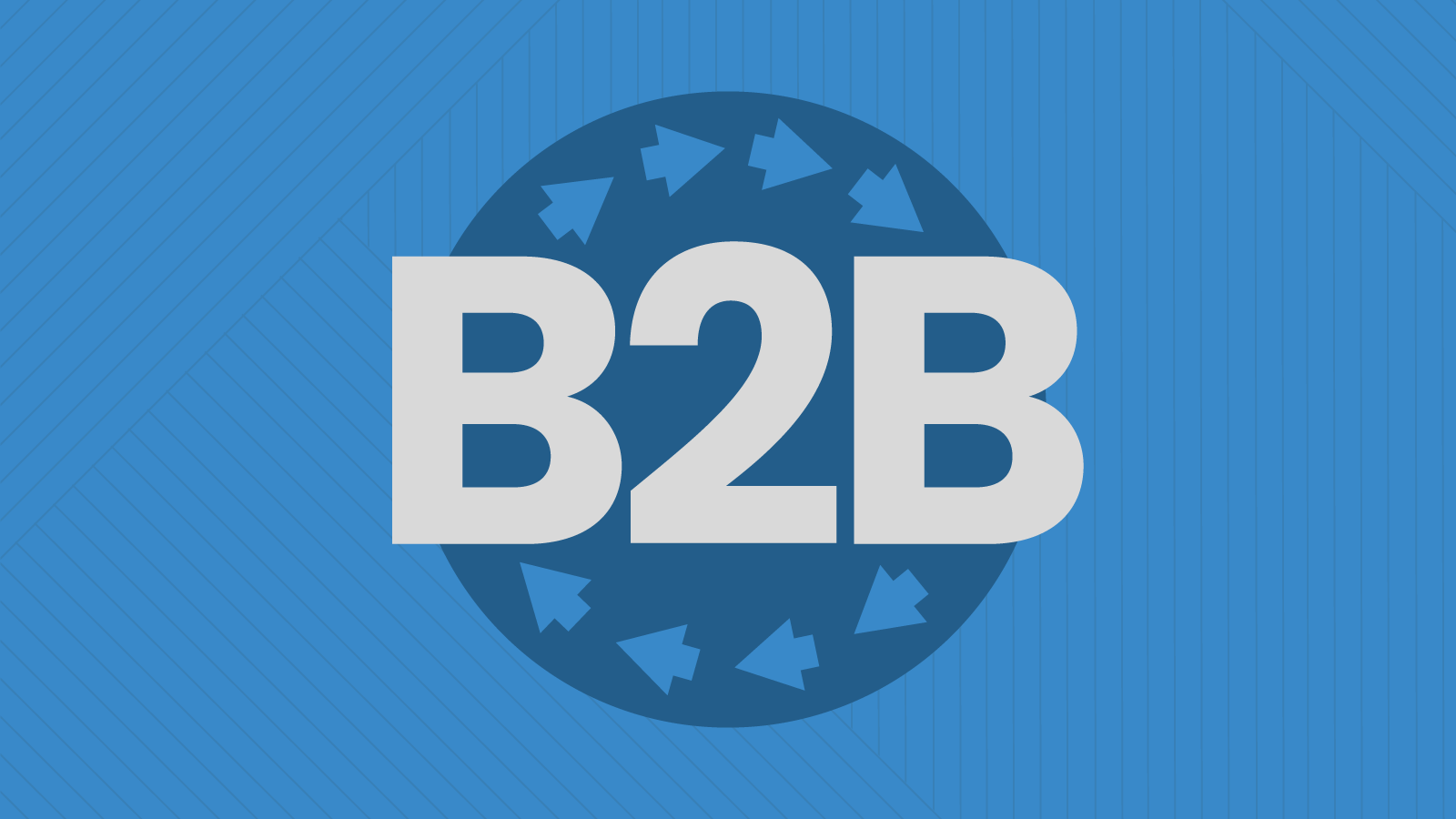
Email Marketing

To paraphrase the ‘70s classic rock song, email marketers are “taking care of business every day in each and every way.” However, a business-to-business (B2B) email marketing strategy often requires a unique approach.
If you’ve been strictly sending emails to consumers up until now, there are some B2B email marketing best practices you should know about to help you reach the right people with the right messages at the right time.
There are certainly email marketing best practices you should follow that relate to both B2C and B2B subscribers. We’re not going to waste your time telling you to write compelling subject lines and provide a clear call-to-action (CTA). You’re way beyond that advice.
However, there are some differences between B2B and B2C marketing that you should keep in mind.
Whether you are selling directly to consumers or marketing products and services to other businesses, it’s always people who ultimately make purchase decisions. Still, there are differences between B2B and B2C audiences. That’s why you really need to understand your target personas.
Most consumer brands keep one person (or a household) in mind as they create buyer personas and marketing strategies. In many enterprise organizations, however, purchase decisions are made by more than one individual. Sometimes entire committees are involved in evaluating a B2B purchase.
B2B email marketers need to understand who they’re talking to in order to deliver effective messaging. Here are some of the people you may need to consider:

Here’s a real-life example of how it could work for an enterprise team evaluating Sinch Email on Acid:
A lot of B2C purchase decisions are made quickly and impulsively. Most consumers don’t spend a ton of time debating whether to buy a new brand of toothpaste or try a different restaurant. On the other hand, many B2B purchase decisions tend to take longer.
B2B buyers do more research, talk to colleagues, and often need to get approval before making a significant purchase. These decisions can’t be made on a whim. In fact, Gartner reports that 77% of B2B buyers say their last purchase was “complex or difficult.”
As an email marketer, you need to have a solid understanding of the customer journey or path to purchase. How do each of the personas within an organization play a role in that journey? What valuable information do they need to know and what objections must be overcome to take the next steps?
Of course, email is the perfect communication channel for nurturing different segments of people over a longer period of time. Your job is to figure out how email fits into the sales funnel.
List building for B2C email marketing is pretty straightforward. Consumers who are interested in your brand subscribe because they like you and want to know about upcoming deals and product news. They often end up on your list after making their first purchase.
In B2B marketing, new email subscribers can end up on the list in a wider variety of ways:
This distributed approach to contact acquisition may help you collect leads and data, but it can quickly get complicated. Important B2B email marketing best practices include being proactive about managing your list to support deliverability, security, and compliance.
If you’re new to B2B marketing, you may have some preconceived ideas about how the email strategy and execution really work. Let’s blow some of those assumptions out of the water and debunk several big-time B2B email marketing myths.
It may be true that business and messaging applications like Slack and Microsoft Teams have replaced a lot of the short, internal messages we once emailed to coworkers. But the inbox is still an integral part of the day for most B2B prospects.
Research from McKinsey suggests the typical worker spends around 28% of their week reading and checking email. According to an article from Harvard Business Review, the average professional checks their email 15 times a day. That’s about once every 37 minutes.
Conversely, research from Zippia suggests that most people spend less than 15 minutes of their workday on social media sites like LinkedIn.
In most industries, email is the best marketing channel for reaching B2B prospects. Don’t believe the hype… email is not dead. Your leads definitely use email.
A major misconception about B2B buyers is that their decision-making is void of emotions. We assume that all we need to do is provide some strong stats that relate to the bottom line, and they’ll be sold. We think consumers are emotional and B2B prospects are logical. That’s just not true.
A study from Google and Motista found that B2B customers were more emotionally connected to vendors and service providers than consumers are to brands. The study’s authors explain that many personal consumer purchases are low risk, but a business-related purchase is likely to have more at stake.
Responsibility for a multi-million dollar software acquisition that goes bad can lead to poor business performance and even the loss of a job. The business customer won’t buy unless there is a substantial emotional connection to help overcome this risk.
As humans, we tend to use logical conclusions to justify purchase decisions that are based on emotions. Arguably, the most important emotion in effective B2B marketing is a feeling of trust.
B2B email marketing does not have to be dry and boring. While you may need to stick to your brand voice and style guidelines, there’s no reason you can’t get creative. That includes the potential to add interactive dynamic content in email campaigns.
Some of the most recognizable B2B brands around have plenty of personality. If your competitors’ emails are stiff and stilted, making your messages more memorable will help you stand out in the inbox.
Here are a couple of B2B brands that got creative with email design and copywriting. Invoices and business cards may not exactly scream fun – but Harvest and Moo delivered some flavor with these two B2B email campaign examples.
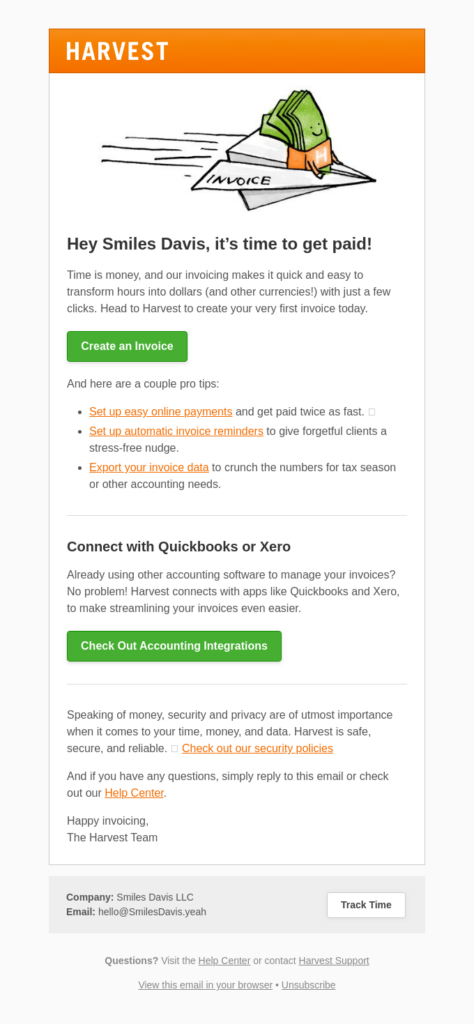
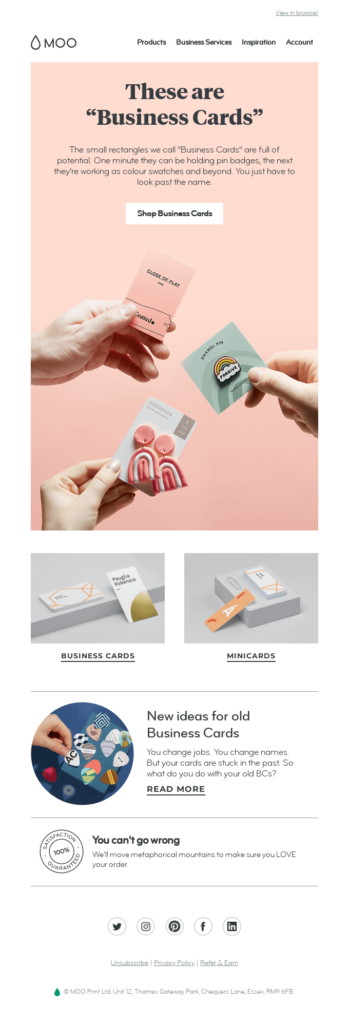
Getting more imaginative with B2B email marketing campaigns doesn’t have to be all about design either. Writing more creative calls-to-action could significantly boost click-through rates and conversions.
Another outdated assumption about B2B buyers is that they spend all their time in front of desktop computer screens. So, sending mobile-friendly emails doesn’t have to be a priority. That’s another myth.
Now, it might be true that your B2B list skews more towards desktop opens than mobile. But, if you look back at the trend, you’ll likely notice those mobile numbers slowly creeping upward over time.
The truth is, you don’t know when your subscribers will open an email on their smartphone or tablet. What if they’re checking their messages on their phone in the morning to get a jump on the day? What if they’re reading emails on their commute or checking in at work over the weekend?
B2B subscribers may first open a campaign on a mobile device, and if it’s of interest, they’ll go back to it when they get to their desks. A mobile-first approach to email production is a good way to ensure your campaigns look their best on any size screen.
Don’t assume you’re exempt from following regulations that protect people’s privacy just because you sell to businesses. The General Data Protection Regulation (GDPR) and the California Consumer Privacy Act (CCPA) apply to B2B companies as well.
In the CCPA for example, the term “consumer” is defined as anyone who is a “natural person” (aka a live human being). You need to obtain consent to email B2B subscribers and you need to properly protect their personally identifiable information (PII).
While the CCPA did have a temporary moratorium for B2B communications, that has since expired. The GDPR has no B2B exemptions.
Now that we’ve cleared up confusion around the differences between B2C and B2B marketing, and addressed some of the misunderstandings, let’s get to the B2B email marketing best practices.
Here’s some advice on what you should do to nail your B2B email marketing strategy:
The more you know about your B2B customers and prospects, the stronger your email program has the potential to be. Subscriber data provides the intelligence you need to get much more strategic. But not all data is created equal. The best stuff is zero-party data and first-party data.
What about second- and third-party data? Second-party data is information you may obtain from co-marketing partners – or first-party data someone shares with your company. Third-party data comes from a variety of sources and is typically offered to businesses from a data aggregator for a fee.
You will no doubt get cold sales emails from companies promising to sell you “audience insights” such as info about your competitors’ customers. That’s third-party data and it’s less accurate and less reliable than zero- and first-party data.
Be strategic about how you build signup forms on your website. The fields you require new contacts to fill out will dictate a lot of the data you’ll use for email segmentation and personalization.
One type of data that you definitely do not want to buy is email addresses. It may be tempting to pay for a list of what you believe are relevant contacts, but that can quickly get you into trouble with deliverability and spam/privacy laws.
Unfortunately, “The state of email deliverability 2023” from Sinch Mailgun found that nearly 17% of B2B respondents admitted to purchasing emails to add to their list. Another 13% admit to scraping the web to harvest email addresses. Sending unsolicited emails to purchased or scraped contacts makes you a spammer – plain and simple.
Make sure you receive explicit consent from every contact you add to your B2B email marketing list.
Keeping your contact database up-to-date and clean is a major B2B email marketing best practice. Maintaining list hygiene is important and can be trickier for B2B senders.
One of the challenges relates to all the different sources of B2B contact acquisition we mentioned earlier. If people are filling out hard copy forms at conferences, registering for webinars, signing up for custom demos, and more – you’ve got a lot to manage. A helpful solution is an email validation tool that can verify addresses at signup or check the entire list. These solutions can prompt people to correct typos, stop the use of disposable emails, and prevent bot attacks through signup forms.
Adding to the list-hygiene complexities is the fact that business professionals change jobs a lot. Statistics suggest people switch employers 10 to 15 times in their lives, and 91% of millennials expect to get new jobs every three years. When people change jobs, they get new work email addresses, and their old ones may start bouncing.
A high bounce rate reflects poorly on your sender reputation with mailbox providers like Gmail and Outlook. When there are too many outdated and invalid addresses on your list, it can thwart your efforts to reach the inbox, and you’ll end up in spam instead.
It’s not the size of your list that matters most – it’s what you do with it that really impacts B2B email marketing performance. Breaking your full list down into smaller segments lets you get more strategic with email marketing efforts.
Remember those B2B target personas we mentioned earlier in the article? That could be an excellent way to segment your list of contacts. Remember that data we mentioned collecting in the first of our B2B email marketing best practices? That’s exactly what you need for effective email personalization.
When you segment your list, you can deliver more relevant content and messaging to potential customers that moves them through your sales funnel. When you personalize B2B emails, you’re supporting a lasting relationship, making an emotional connection, and establishing trust.
But go beyond sticking names in subject lines and email copy. Most B2B prospects won’t be too impressed with personalization like that. Show them you really care by sending personalized emails actually add value. Mailjet’s Inbox Insights 2023 found that those with successful email programs were more likely to personalize campaigns with content and product recommendations.
Once you’ve built a list and segmented your subscribers, the real B2B email marketing strategy begins. A big part of the process is using the inbox to nurture leads and convert them into new customers.
Nurture emails and drip campaigns are key in B2B marketing automation because they help keep prospects engaged and your company top of mind during all that decision-making and the long sales cycle.
How you nurture B2B contacts with email will depend on the segment/persona, the stage of the customer journey, and the pain point (or problem) that brought an individual to your company in the first place. Nurturing continues after someone converts from being an email subscriber to a paying user or customer. That’s where your welcome email series as well as B2B onboarding emails come into play.
Here’s a B2B email example from Help Scout that onboards new users who are on a free trial:
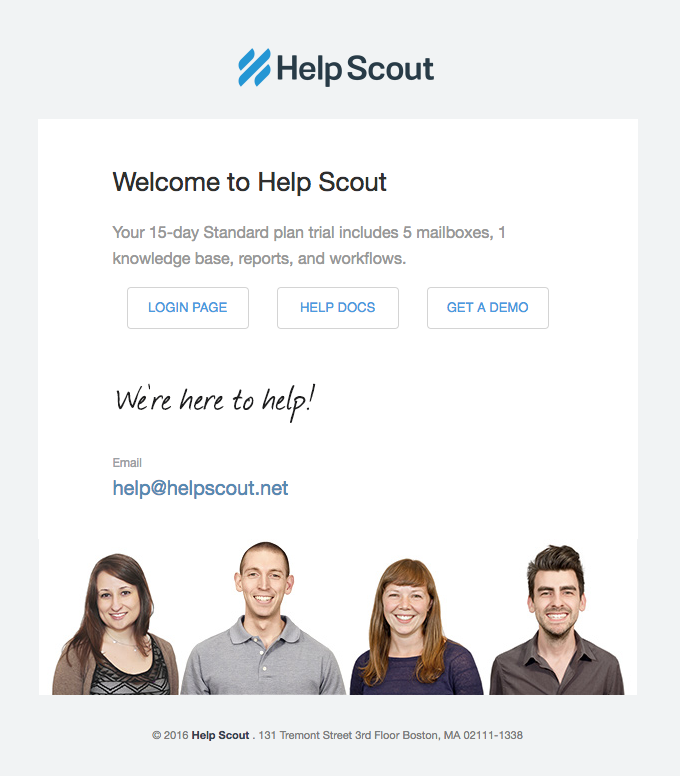
The way someone ended up on your list can inform the email nurture sequence you put them into. If they converted on a specific landing page, by attending a webinar, or by downloading a piece of content, what does that tell you? What problem are they trying to solve and what information would help them?
When you know who you’re talking to and what they’re trying to accomplish, you should also know a thing or two about the kinds of content marketing pieces that should go in your B2B nurture emails.
Be mindful of how often and how much you ask for the sale as you email your B2B leads and prospects. Getting too pushy too soon is a good way to annoy those contacts, convincing them to unsubscribe as they lose trust in your brand.
Be helpful and informative by sending information and links to content that would be of interest to your prospects. Thought leadership content is excellent for establishing trust and sharing unique insights from your company. Case studies are also powerful B2B content to deliver to the inbox, especially if they reflect the industry or job title of the person you’re contacting.
This B2B email newsletter from Modern Recruiter is packed with high-quality content:

Keep in mind, “educational content” doesn’t have to be boring either. B2B emails can share compelling stories as well as surprising statistics. Don’t be afraid to tastefully ask for the sale eventually, but make sure you get your timing right.
B2B buyers are always evaluating the true value of possible purchases. But it’s not all about the money. If your email subject lines focus on the benefits of choosing your business’s products and services, you’ll get better open rates and people will actually read and engage with your message.
Here’s a quick refresher on the difference between features and benefits:
Subject lines that include benefits help potential buyers imagine what life (and their job) will be like after they choose to work with your company. Use B2B email subject lines to tell people what’s in it for them. Or at least allude to the benefits so that they open your messages to find out more.
We know, we know. B2B email marketing can totally be colorful and creative, but there is such a thing as going too far.
Many professionals are very marketing savvy. And when B2B email campaigns look and feel like flashy, in-your-face marketing, there will be people who become skeptical of your offers. Your primary goal is to get your message across. That means, don’t sacrifice clarity for crazy, clever ideas. If email designs cause clutter and confusion, they aren’t helping you out.
Here’s a B2B email example from Stripe that has splashes of on-brand color and a simple graphic, but the design feels professional, and the content is easy to consume:
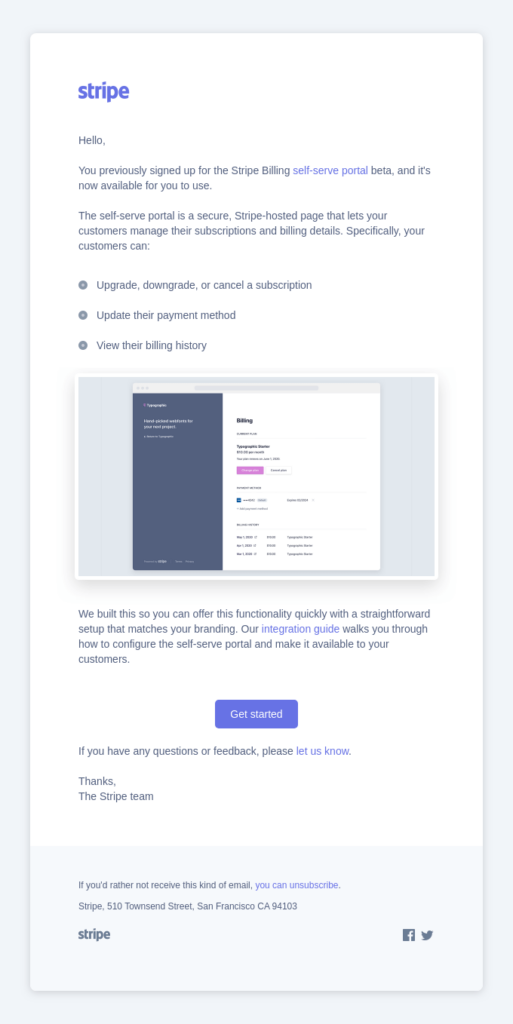
Sometimes, very simple email designs can feel more personal and honest, which is a good thing if you’re trying to establish trust. Consider sending messages that are a bit more stripped down and look more like plain text emails – or what you might call “minimalist email design.”
That being said, every email list is unique. The only way to know for sure what resonates and works in your B2B emails is to do some testing. A/B testing the performance of simple vs heavily-designed HTML emails should guide your approach.
Email authentication protocols tell mailbox providers that it really is your company sending messages and not a bad actor posing as your brand. Authentication methods such as SPF, DKIM, and DMARC help mailbox providers stop spammers and scammers from reaching the inbox, which in turn protects their users.
Those users are also your customers and subscribers, so you should want to protect them as well. Email phishing scams target organizations (and the people inside them) just as often as they go after consumers… maybe more. These are known as business email compromise (BEC) attacks.
Sometimes, bad actors will try to impersonate a company that the target organization works with through a tactic known as email brand spoofing. They can make it appear as if an email came from a vendor or partner, but it’s actually malicious.
Strong email authentication helps prevent this from happening. It’s yet another way to establish trust with B2B email marketing. As a bonus, it will also improve your sender reputation, which means better email deliverability and your messages avoid the spam folder.
If you want to increase the lifetime value (LTV) of B2B customers, keep engaging them with emails long after they make a purchase. It starts with welcome messages and onboarding emails, but it can go much further than that.
Transactional emails are also an important part of B2B email communications. That includes delivering invoices, account creation messages, password resets, shipping updates for physical products, and renewal emails for digital subscriptions.
This B2B email marketing example from Loom delivers year-end data on how the customer used the platform. It’s a nice way to show the value of a purchase just as users are re-evaluating a product and deciding whether to renew a software subscription.
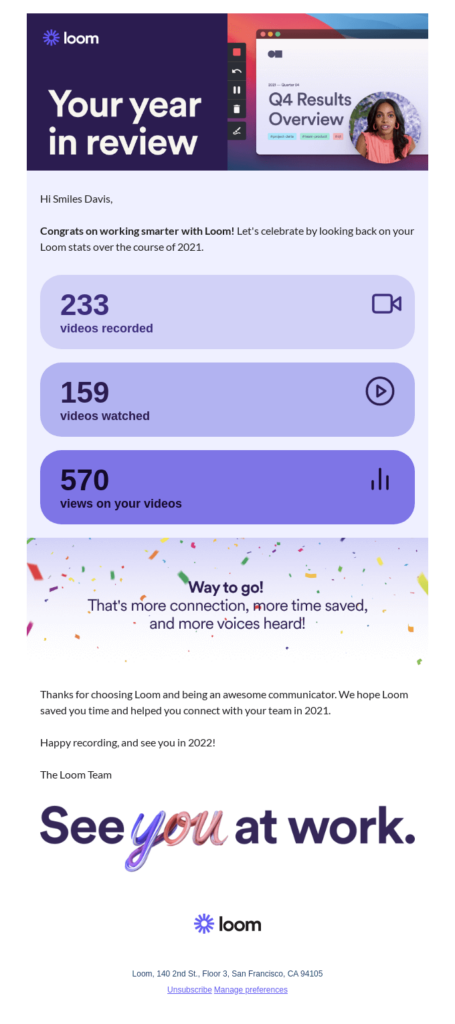
Here’s a B2B email marketing best practice for the developers out there: Keep Microsoft Outlook email clients in mind.
Outlook, especially the desktop versions, can be problematic for email rendering. Of course, the vast majority of businesses out there are using either Outlook or Google Workspace (Gmail for business) for internal emails.
In the analytics from Sinch Email on Acid, you’ll find a breakdown of the email clients your list uses the most. If you’re a B2B email marketer, it’s highly likely that a significant percentage of opens are occurring in Outlook clients. That means you need to optimize the inbox experience for those contacts.
To get started, check out our tips covering 11 common Outlook email rendering issues. A lot of these problems stem from the fact that Windows versions of Outlook use Microsoft Word as the rendering engine. The good news is that Microsoft plans to release a new Outlook for Windows in the near future, which could make life a little easier for email developers. The bad news is that the old desktop versions will still be out there for a while.
There’s only one efficient and effective way to make sure your B2B emails look their best in every inbox and that’s to make pre-send testing part of your email quality assurance (QA) process.
With Sinch Email on Acid, you can preview how campaigns are displayed in more than 100 different clients and devices. That includes major mailbox providers like Gmail, Outlook, Yahoo Mail, and Apple Mail as well as mobile previews for iOS and Android and dark mode email previews. Plus, every paid plan gets unlimited testing.
But this platform does more than that. Use our automated email marketing checklist to review everything from typos and links to accessibility and blocklistings. We’ve built Email on Acid to help you put your best email forward so you can take care of business without worrying about what might happen after you hit send.